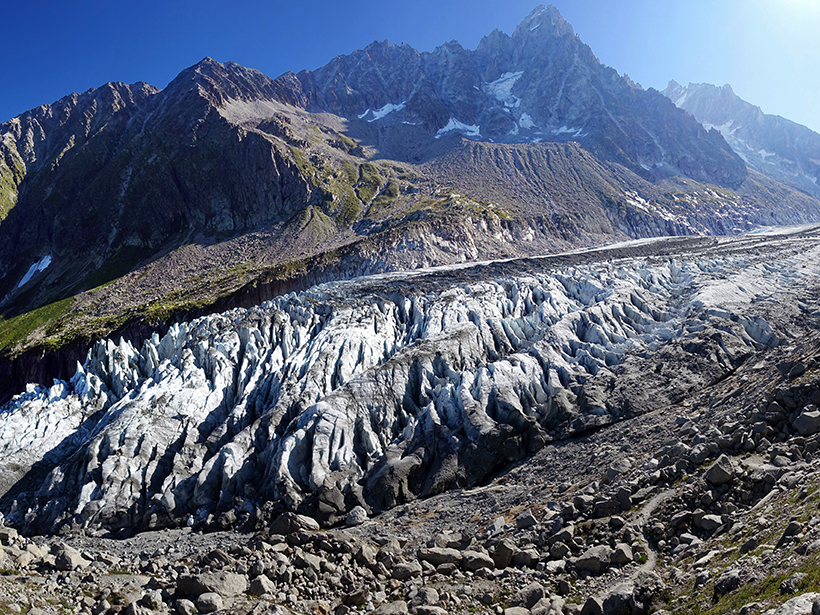Glaciers are powerful agents of erosion that have profoundly altered Earth’s surface for millennia. However, the mechanisms that rule glacial erosion are not fully understood, mainly because they happen below the ice, hidden from view.
One of the biggest open questions among glaciologists is why some glaciers are more erosive than others and which factors are behind such differences.
An international group of researchers led by Simon Cook, a glaciologist at the University of Dundee in Scotland, might have found an important piece of the puzzle. By compiling the erosion rates, sliding velocities, and climate data from 38 glaciers, they realized that precipitation is the most important factor controlling glacial erosion. The researchers published their findings in Nature Communications in February.
New Analysis of Existing Data
“That was a new finding, the fact that precipitation might have this control over the amount of erosion that takes place.”
Cook and his colleagues were inspired by a paper published in Nature in 2015, in which Michele Koppes, a glaciologist at the University of British Columbia in Vancouver, Canada, and her colleagues measured the amount of erosion from 15 glaciers in Antarctica and Argentina. Using latitude as a proxy for temperature, they found that glaciers in temperate areas of Patagonia were hundreds of times more erosive than their colder, Antarctic counterparts.
Cook and colleagues decided to include climate data in their analysis, particularly looking at precipitation. “What we found is that there is no systematic increase in erosion rate with warming temperatures,” Cook said. “It wasn’t like a sliding scale where when you go warmer and warmer, you get more and more erosion. That wasn’t really the case, but with precipitation that was the case.”
“That was a new finding, the fact that precipitation might have this control over the amount of erosion that takes place,” Cook said.
Cook explained how two forms of precipitation, rainfall and snowfall, influence glacial erosion. On the one hand, water from rainfall on a glacier can percolate to its base, lubricating the interface between ice and rock and allowing the glacier to slide faster. This process leads to more erosion. The rainwater itself could even flush some sediment out of the glacier, again enhancing the amount of erosion that takes place. Snowfall, on the other hand, can accumulate on the surface and create a thicker, steeper glacier, which again promotes faster sliding and higher erosion rates.
Cook and his teammates found that the highest amounts of erosion were taking place beneath relatively warm glaciers, “so temperature does have a control, it just doesn’t have a systematic control.” Instead, temperature acts as a threshold that, when crossed, allows for rapid erosion when accompanied by enough precipitation.
Koppes, who was not involved in the current study, agreed. “That confirms the study that I did, the 2015 study, that [suggests] when you actually turn on the amount of water at the bed of the glacier, it bumps up the erosion rate by an order of magnitude or two,” she said.
Statistic Limitations
Cook acknowledges the underlying data for the study are “not completely bulletproof, there’s a huge amount of variation in those data.” The main culprits are the inherent variability for each glacier’s particular characteristics and the different techniques used by the researchers who acquired the data.
“It’s easier to get to the surface of the Moon than it is to get underneath a glacier and know what is happening down there.”
In some cases, researchers measured only the amount of sediments dissolved in meltwater streams coming out from glaciers, whereas others also accounted for the cobbles and boulders they carried. Other researchers looked directly into the ice, chiseling into it and measuring the volume of sediment being transported by the glacier itself. In other cases, where the glaciers discharged directly into lakes or the sea, scientists took sediment cores from the bottom of those water bodies, trying then to estimate how quickly that sediment accumulated.
“Even though you’ve got this wide range of measurement techniques, despite all of that, you still get a significant relationship that’s actually reasonably strong and gave us confidence that there’s this real relationship between how quickly glaciers move and how much erosion they do,” Cook said.
Another issue is the limited climatic data available in many remote areas. Cook defines their data set as “quite coarse.” In the future, Cook calls for other teams using higher-resolution climate data or even gathering climatic data in situ.
“The real mileage going forward is probably in exploring further this relationship between precipitation and temperature and the rate of erosion underneath glaciers,” Cook said.
Koppes agreed. “It’s easier to get to the surface of the Moon than it is to get underneath a glacier and know what is happening down there, so there are a lot of assumptions that go into these measurements, she said. “I think the next question is actually delving into why all the variability, what are the differences between each one of these glaciers.”
—Javier Barbuzano (@javibarbuzano), Science Writer
Citation:
Barbuzano, J. (2020), Precipitation plays a key role in glacial erosion, Eos, 101, https://doi.org/10.1029/2020EO141249. Published on 10 March 2020.
Text © 2020. The authors. CC BY-NC-ND 3.0
Except where otherwise noted, images are subject to copyright. Any reuse without express permission from the copyright owner is prohibited.

